When the three of us left Uyuni, there were two options to exit Bolivia. Initially, like all our overlanding friends, we planned to take the southern route to Argentina, a country everyone raves about. We realized, however, that this meant missing out on Valle de las Rocas and the northern part of Chile.
“At which border will you leave Bolivia?” the vet asked. He needed to know the answer for Maya’s health certificate details. “Ollagüe, Chile,” we said and our fate was sealed.
Ollagüe
The border crossing on February 12th was easy and straightforward. Mark and I had eaten most of our perishables, leaving us with an empty fridge and meager food pantry. We checked out of Bolivia after scanning a QR code, filling out forms, and receiving the exit stamp. There was some confusion, since we each had two entry stamps, due to our border run from Peru, a few months ago.
We received new passport stamps for the new country, obtained a Chilean TIP (Temporary Import Permit) for the vehicle, and handed over Maya’s international health certificate. Another agriculture official entered the camper and – before he started opening cabinets – I asked him which items were prohibited: fresh meats, fish, eggs, honey, and produce. I gave him whatever we had left of one onion and a lime. Then, we chatted about his experiences as a border agent, Afghanistan veteran, and dog owner.
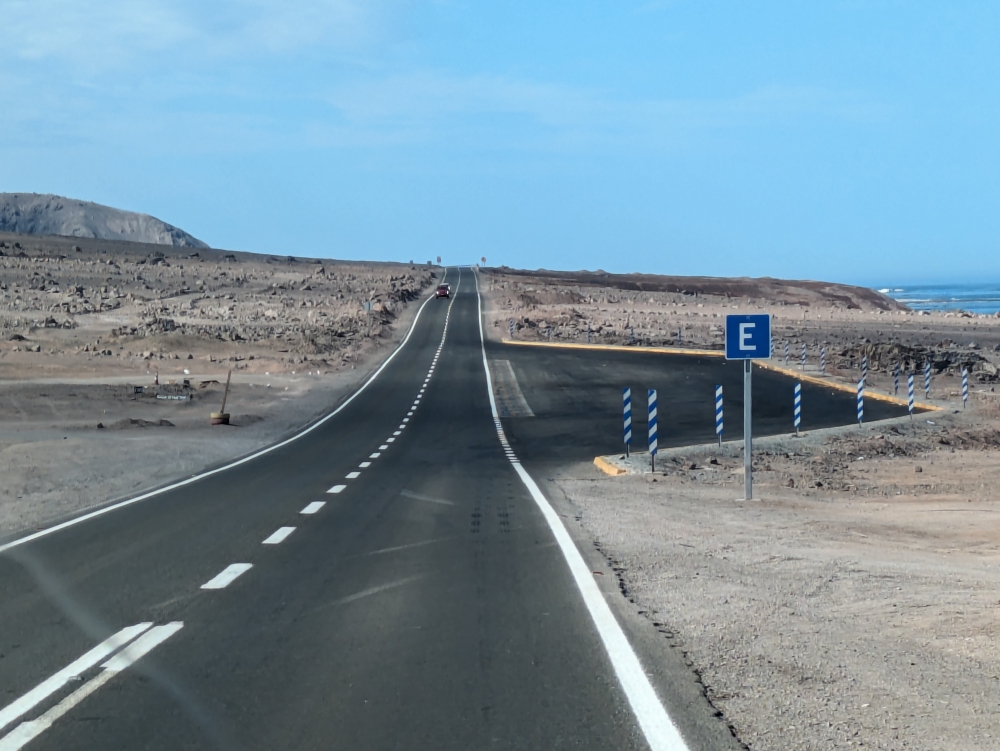
The roads in Chile are amazing!
From the moment we entered Chile, the bumpy, gravel road surface turned into beautiful, smooth asphalt. A joy! We stopped in the town of Ollagüe to find local money and vegetables. We failed on both accounts, but managed to fill our tanks with potable water.
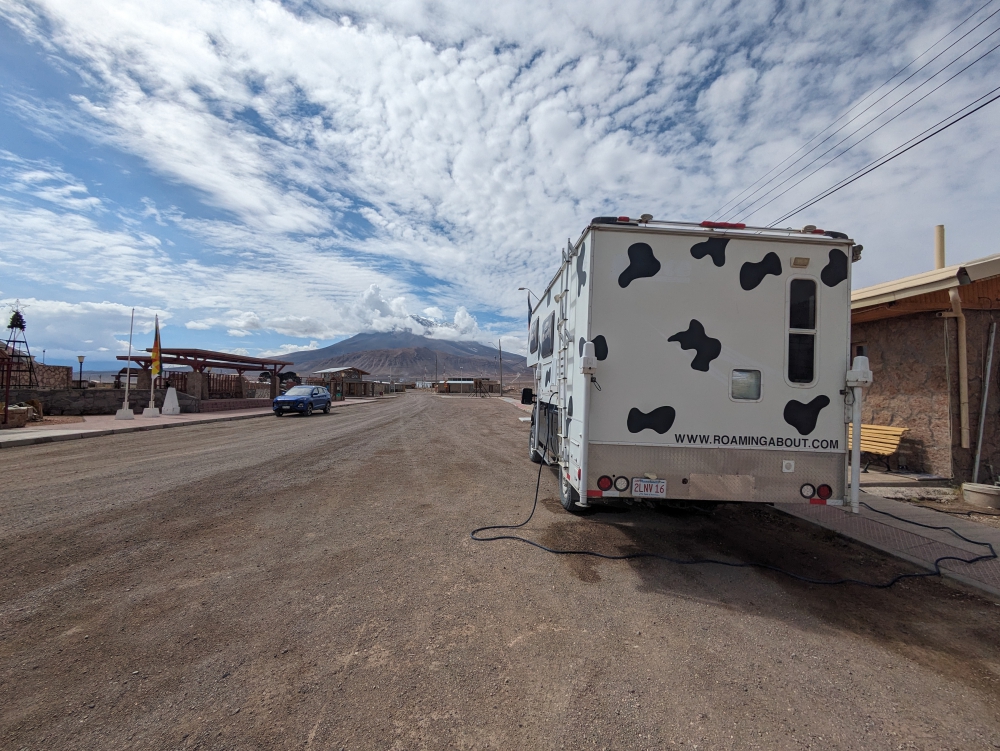
Topping up with potable water in Ollagüe
The volcano route
Another reason we picked this border crossing was the appeal of a scenic drive in the high Andes, past lakes, altiplano (high plains), and volcanoes. Unfortunately, the weather was cloudy and rainy. The views could have been better (where were the anticipated snowy tops?), but we still enjoyed the ride and camping spots and ate whatever we could scamper from the cabinets. There were no stores, banks, or fuel stations along this multiple-day trip. At least we weren’t spending any money.
We could have sped up towards the city of Calama, really not that far away, but we wanted to cherish the surroundings and take our time. Mark, Maya, and I climbed one of the small volcanoes before breakfast one morning. I admit to seriously miscalculating this effort at over 13,000ft (4,000m). I had read this excursion would take 20 minutes up and 15 minutes down. Right. For fit millennials maybe…
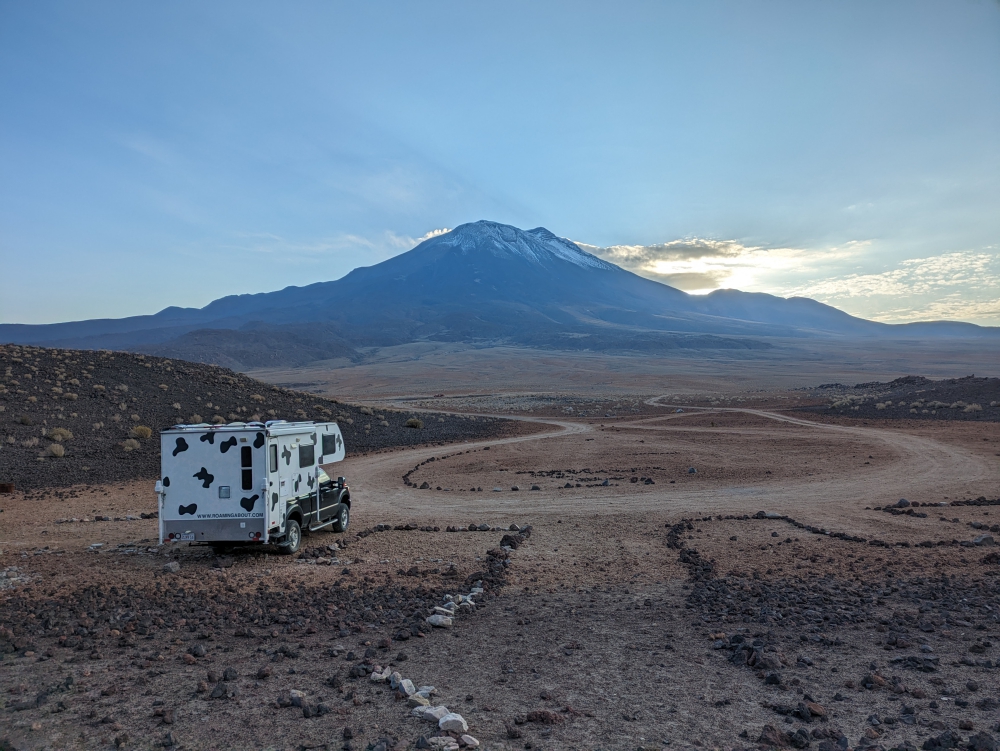
Parked between two volcanoes
I did not bring any water and my stomach growled after ten minutes of effort. We persevered on the steep and slippery trail, which consisted of volcanic rock pieces. Despite the blue sky, I didn’t find the view from the top worth the effort.
After forty minutes to reach the crest, we still had a long way to go around the crater and slip and slide down the other side, plus another mile just to return to our camper. Once back on steady ground, Mark took Maya home and picked me up with Thirsty Bella. I felt weak and sick by then. Not a mistake I will make again!
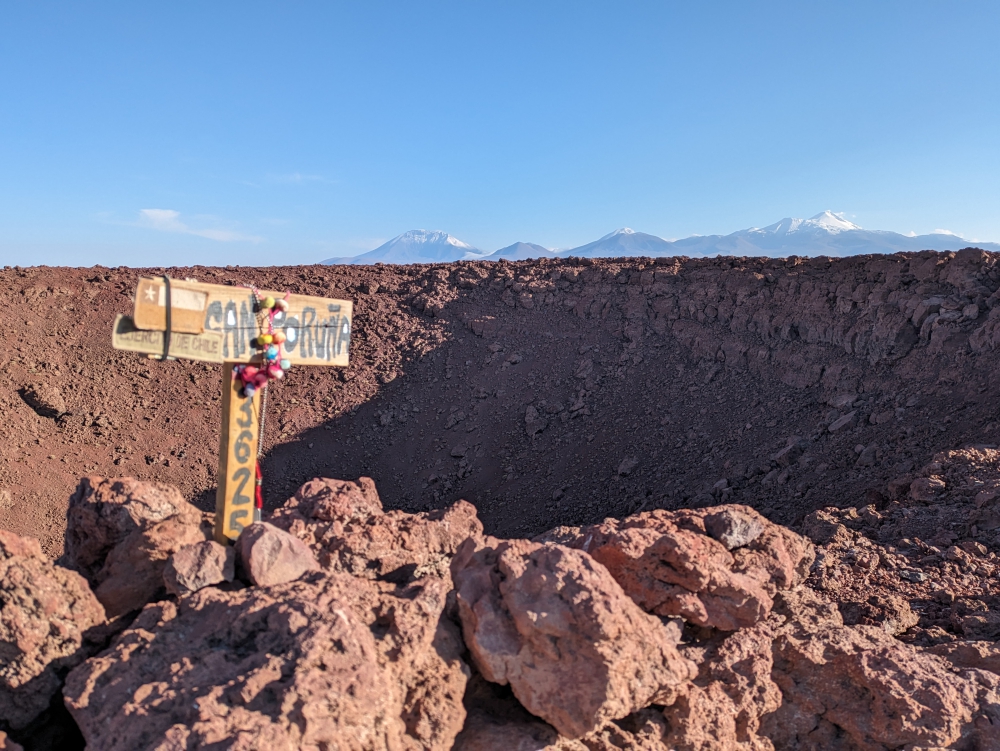
Crater at the top of the small volcano
Chiu Chiu
We needed food, so after three days of lingering and making little progress, we descended the Andes Mountains into the Atacama Desert and stopped in the cute village of Chui Chui. A quick stroll brought us to the cute square and an old adobe church. The Iglesia de San Francisco was built in the mid-16th century and would be the first in a series of attractive temples I would photograph. If only we had Chilean pesos, or fresh food, to stay longer… Instead, we drove to Calama.
Calama
Lots of warnings in iOverlander about break-ins in this supposedly ugly and dangerous town (the reason we installed security film against the car windows in Cusco, Peru), meant I bought all the groceries, while Mark and Maya stayed with the camper. Nothing looked suspicious and everything was probably okay – security guards patrolled the parking lot – but better safe than sorry. Not being able to split the list with Mark and my excitement about being in this store lead to a two-hour shopping spree. I was pleasantly surprised at the prices for generic brands in this seemingly Western country.
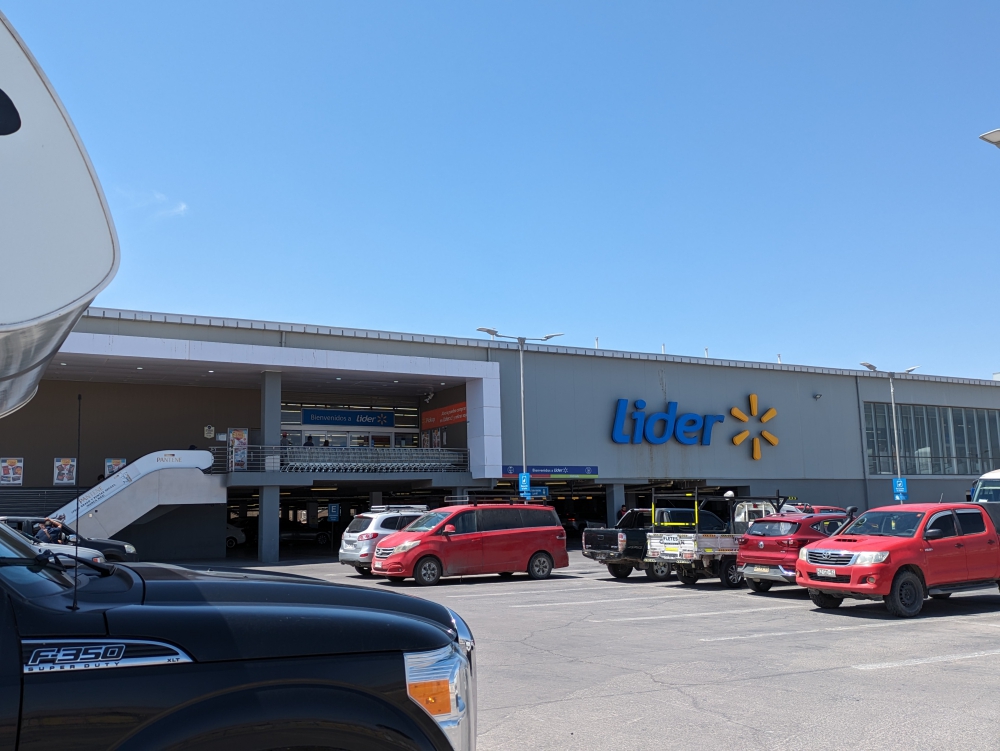
Finally shopping at a big grocery store again (this one is related to Walmart), after a month of tiny – and no – stores.
If this was supposed to be one of the worst cities in Chile – clean, organized, dumpsters, street names, pavement, courteous drivers – we looked forward to what else this country had to offer!
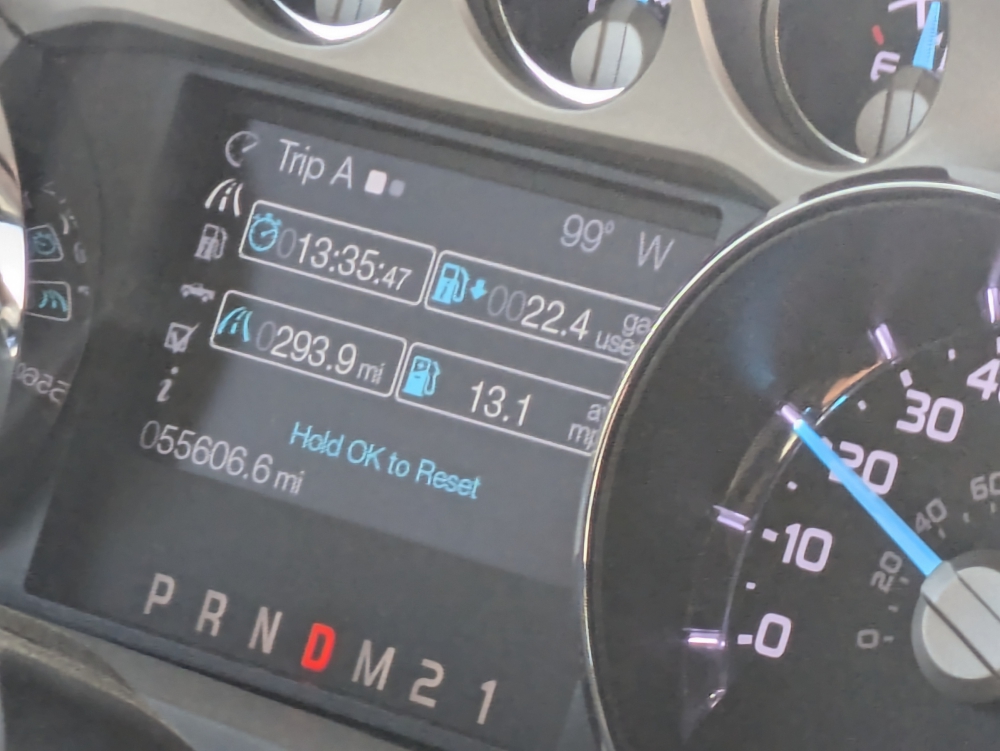
It was hot outside – 99F (see top right on the display)
As we drove westward and then northward, the temperature kept climbing until we found ourselves camped by Santa Fe Dam in the boiling heat (95°F/35°C) and surrounded by nasty horse flies. The Atacama Desert is one of the driest places on earth. Initially, we had thought about taking a week to reach the coast, but in this climate, we would want to keep going as fast as possible!
Humberstone
Luckily, the air cools off at night in the desert, so we had a decent sleep. The following day, whatever we tried seemed to fail. An authentic mummy museum in one town was permanently closed, the hike past geoglyphs elsewhere required both of us to pay (Mark wasn’t interested) as the actual site was 2km away from the entrance gate, and it was extremely hot, so I decided to skip it. There was no shade to camp, so we kept moving. Slowly.
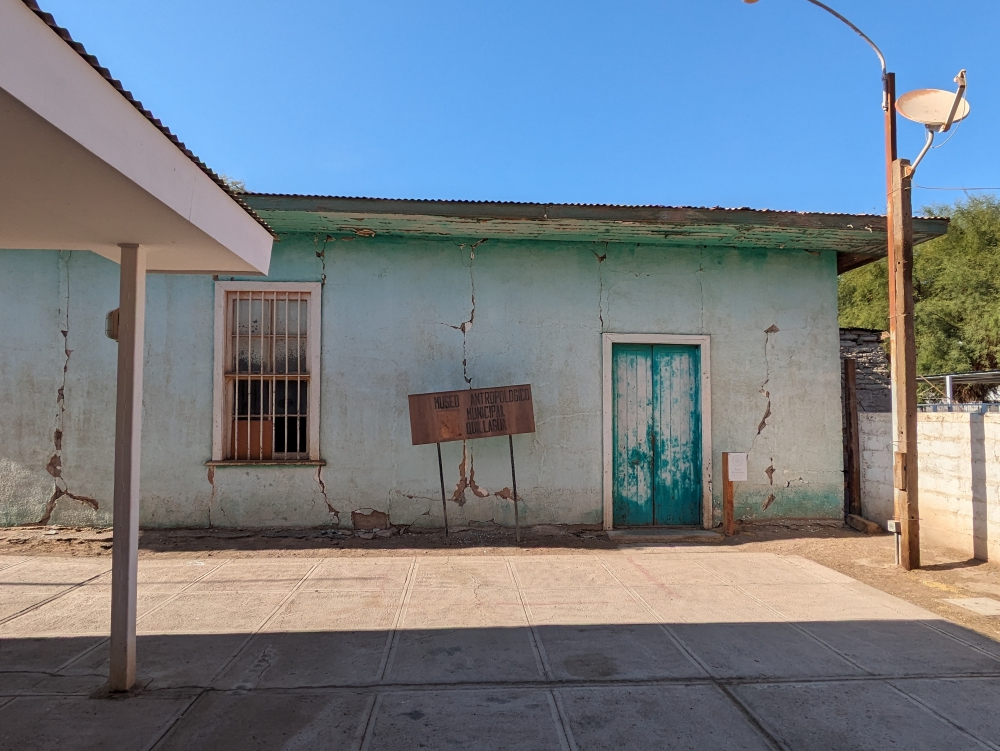
The mummy museum is abandoned and closed.
Thirsty was getting low on fuel, because of the lack absence of fuel stations along the highway, so Mark drove even more conservatively. When we finally filled up, the cost was US$150. Ouch!!! We knew Chilean gasoline was expensive, more than in Peru, but it still shocked us.
My highlight of the day would be… laundry! We had a lot of dirty clothes – the last time we washed them was at the Las Lomas Campground in La Paz, Bolivia – and I looked forward to doing my own loads at a truck stop. Laundromats with self-serve machines are rare in South America and drop-off services – the usual way of getting laundry done – are expensive.
I had a feeling this would be our third strike, because, you know, bad luck comes in three. Sure enough, the washing machines were broken and unusable (the dryers worked). To top it off, we were not able to fill with fresh water either. Luckily, that wasn’t urgent yet. To not feel like this was a total waste of a stop – and to conserve our potable water – we took hot showers for $1 each.
Next, we reached the ghost town of Humberstone, two days earlier than planned… We parked in the lot for our last hot evening, or so we thought, and visited the site in the morning. Maya joined us.
Northern Chile has a lot of mines and (abandoned) mining towns. Humberstone is one of those and was declared a UNESCO World Heritage Site. They extracted saltpeter here, a component used in dynamite and fertilizer.
Since this is a popular tourist attraction, we entered at opening time and strolled the extensive grounds pretty much on our own for two hours. It’s a mysterious, run-down place with a few restored buildings and many interesting exhibits, among which the Santa Maria School massacre, a miner protest that turned extremely bloody when the Chilean army killed over 2,000 civilians.
Iquique
About an hour west of Humberstone, we finally reached the Pacific Ocean again. The last time we saw a sunset over the sea was in Lima, Peru, five months prior. We settled in a parking spot near high-rise buildings and a sushi restaurant. The negative: it was Friday and during the weekend, the bar didn’t close until 2am. Yet, this appeared to be the safest place to wild camp, so we sucked it up.
The beaches were packed, dogs had owners walking them on leash and picking up their poop, trash cans were omnipresent, and the people greeted each other. And, every driver stopped for us to use the crosswalks. Seriously, this felt like another world to us! It was so nice.
Our main objective for being in this city was to run errands, before Sunday, when everything closed. So, on Friday afternoon – it was a little bit cooler here, but very humid – we went shopping in the well-stocked supermarkets and hardware store. On Saturday morning, we strolled the boardwalk to visit downtown and ZoFri, a duty-free shopping area. Mark hoped to find new tires here.
Our truck’s tires were less than two years old (we installed them before this South American journey), but we had been worried about the front one on the right, ever since it was stabbed – leading to five extra punctures in the side wall – in Colombia. Mark didn’t feel comfortable airing down that tire anymore and we had concerns driving gravel and rocky roads.
It was a quest! All-terrain truck tires are not easy to find on this continent. We gathered info and knowledge and, after two hours, when the shops closed, took a cab home, via a pet store to stock up on Maya’s specialized, salmon-based dog food. Yes, Chile has these things. And for a reasonable price.
Back in Bella, we talked about the tire dilemma and decided to buy two, because they were cheaper here than anywhere else. This meant staying until Monday and enduring another loud, sleepless night and a chaotic Sunday family day at the beach. Since this is not our scene, we stayed home and worked.
We drove to the tire place first thing on Monday, ready to leave the city afterwards. Buying the two E-rated tires for $230 went as planned, except for the installation. Unbeknownst to us, the garage only sold the tires. We stored them on the back seat, put Maya in the front with us, and searched for a tire installation place that could help us. Not easy…
After trial and error, we found two local guys who used two – and eventually three – jacks to get the work done for another $15: remove all wheels (one side at a time), discard two tires, mount two new tires, move the older tires to the front, and install the pristine tires in the back. Balancing was not needed, because “front tires don’t need to be balanced.” The entire time, I held my breath and kept repeating the mantra “This is a disaster waiting to happen.”
El Loa seaside
And then, we were ready for a beach hopping “vacation.” We checked out a few free camping spots from iOverlander. They were rocky and unattractive. Looking at the satellite image of Google Maps, we discovered a new spot that seemed alright. Still rocky, but with a calmer bay and tide pools, perfect to take a shower. Except during low tide, when the water was gone!
We decided to spend two nights here to focus on work and research, and managed to sit outside despite the horse flies. They mostly left us alone and by 5pm, the temperature was pleasant.
Playa Hornitos
When the horse flies turned more aggressive, we moved to a rare sandy stretch along the coast. That’s when we noticed the popularity of the beach for Chilean families on vacation. Their summer break lasts at least two months (January and February). During this time, they set up entire villages consisting of tents, shade covers, tables, chairs, beach toys, and toilet tents.
We found a relatively private spot to call our own and lined up our camper on a hump of sand, parallel to the sea. When attempting to move backwards a bit, we couldn’t. I had jumped out of the car and, horrified, watched the wheels dig into the soft sand. Not good!
Mark wasn’t fazed. He let air out of the four tires (good thing we had replaced that damaged one!) and dug out the wheels. During these preparations, a neighbor drove over with a small 4X4 pick-up truck, a shovel, and his friends. We grabbed our heavy-duty tow strap, the man attached the two vehicles, and before we knew it, he tried to pull us out, while Mark revved our engine and spun the wheels harder and harder, deeper and deeper… without budging. Failed rescue attempt #1. It was 2pm.
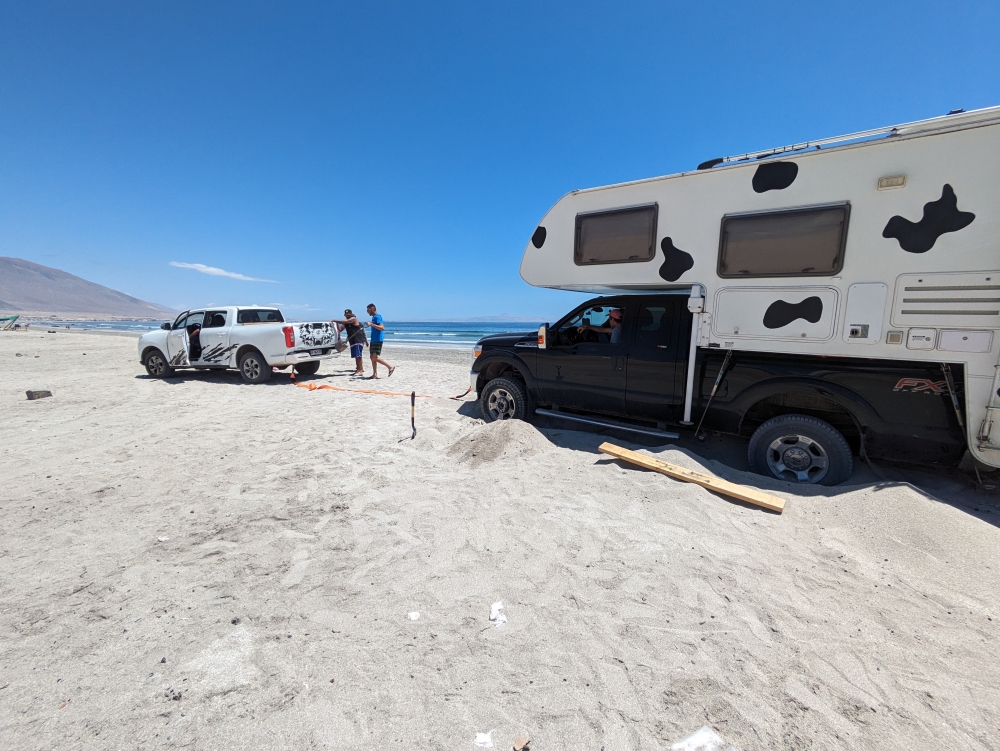
The first rescue attempt failed
Another neighbor came by and lent us a shovel. Now, we had two borrowed ones and our own, collapsible one. For the next four hours, Mark and I dug out the car in the heat of the afternoon. The chassis was touching the sand and nothing budged, even if someone were to pull us out. We removed sand from around the axels, differential, spare tire, springs, and shock absorbers. None of it was easy to reach from the sides, having the camper on top.
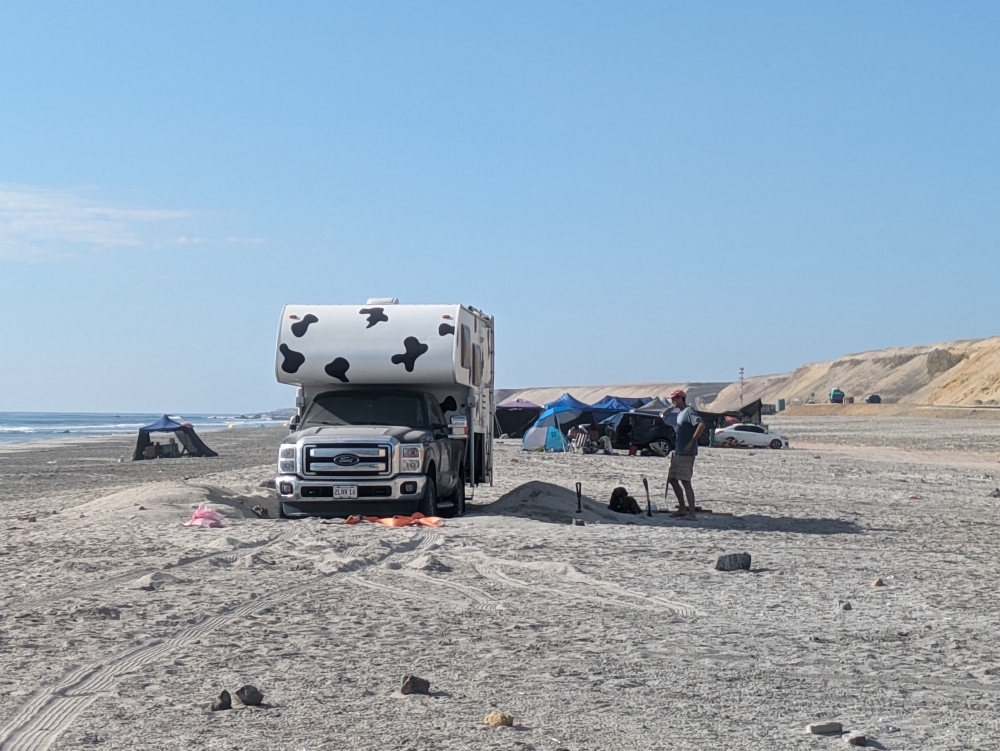
More digging was required.
The mounds of sand around us grew and grew, until they started sliding down into our newly created holes. We should have piled them further away! The second neighbor brought us Gatorade to stay hydrated and offered encouragement: “One day, this will be a good story to tell; another adventure.”
Around 6pm, extremely exhausted, sore, sweaty, and sandy, we felt ready for another rescue attempt. A fleeting thought warned me to wait until tomorrow to start fresh. Thirsty Bella seemed reasonably level. Yet, we wanted to be done with this mess, get settled, take a shower, relax, and have a beach vacation. So, I engaged our neighbor for a second towing session.
Again, we made mistakes, which dug the tires into the beach once more. And, again, we got terribly stuck. After a mere minute, we were worse off than before; the camper extremely slanted and the chassis sunk into the sand. Now, it was a nightmare. Darkness would arrive soon; there was nothing else to do. Sleeping at such a steep angle would be difficult, cooking impossible. To make matters worse, because of the extreme slant, the water pump didn’t work, so we couldn’t access our drinking water!
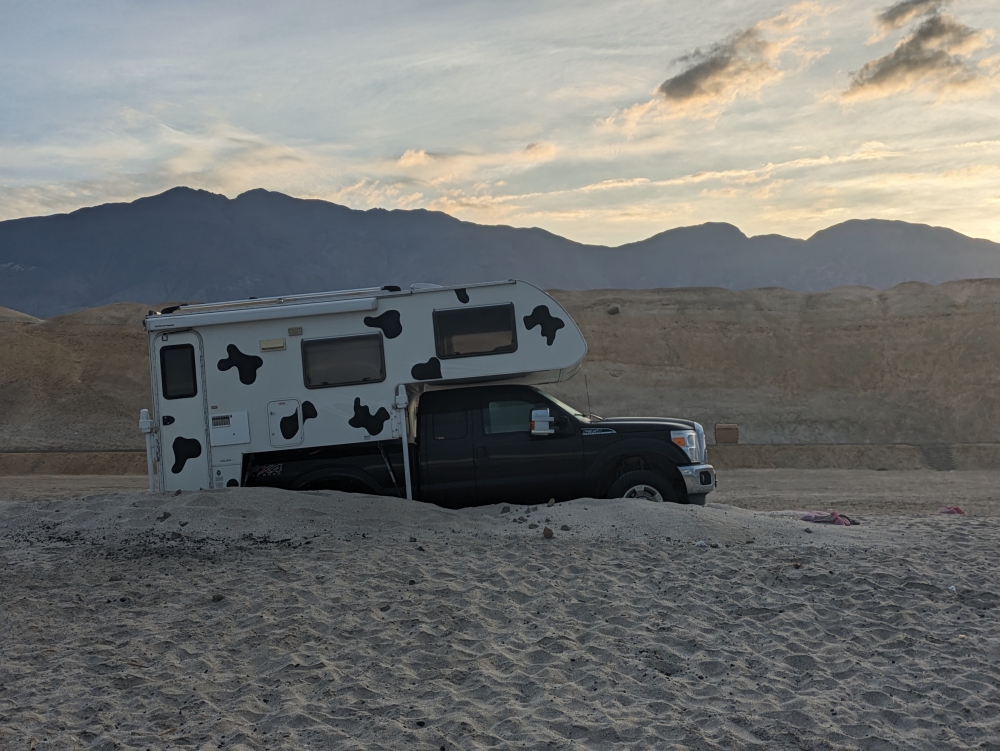
The most unlevel night in our camper
We took showers in the ocean, but couldn’t rinse off. We had one stainless steel bottle to last through the night, for two people and one dog. We had no water for dishes or brushing our teeth. This was one of the most distressing moments on our South American trip. The evening was spent researching and contacting towing companies and trying to get help and/or advice from fellow overlanders.
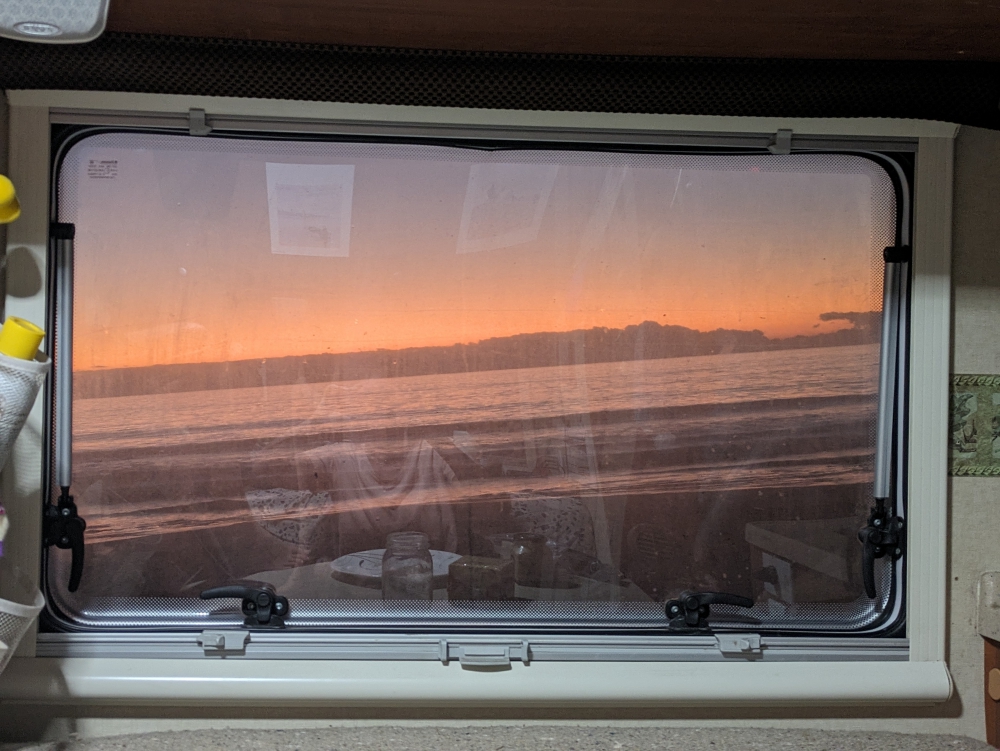
We had to eat, live, and sleep at this angle for twelve hours.
By the following morning, a few options became available to us. Mark started digging again, while our neighbor gave me a ride to a nearby shop to buy drinking water. Then, I helped Mark free the underside of our truck. I won’t go into details about the nastiness we encountered during our excavations.
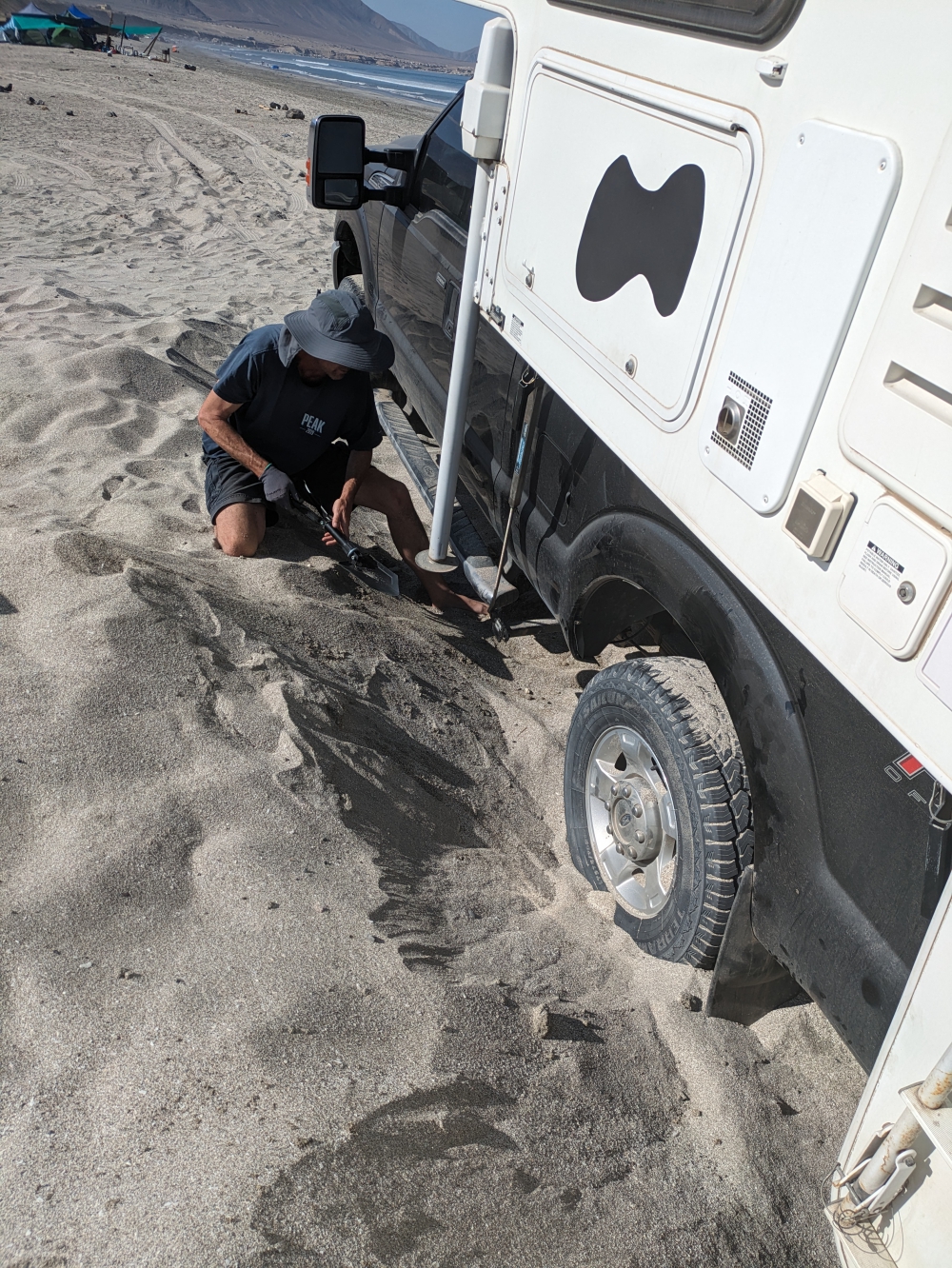
More digging in the morning
To make a long story short(er), we lowered the pressure in the tires to 20% and worked hard for another three hours, until a different camper showed up with a heavier-duty pickup truck, an F150 4X4. He had brought a group of kids and adults with him. The next episode unfolded rapidly…
Our tow strap was attached, the driver pulled steadily, Mark slowly gave gas, and seven people pushed in the back. My sole job was to make sure at all costs that the back wheels would not spin one hair. So, I couldn’t take photos.
My focus was on the rear tire on my side and, before I realized what was going on, the wheels were rolling forward and our home was free! I can’t stress enough how relieved I was to see our camper moving again. Big smiles and applause all around.
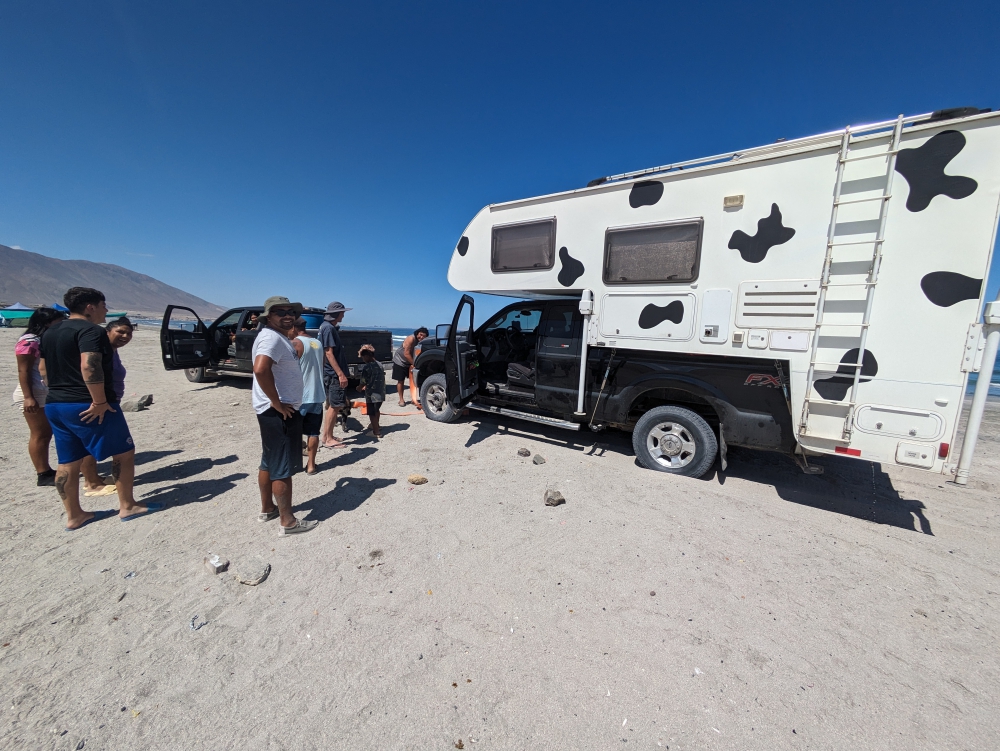
Yes! We are free again!
We thanked everyone involved profusely, gave the driver $20 and a few beers, brought a six-pack over to our first neighbor, and kept smiling and offering gratitude. Wow. That sure was a situation we hope to never repeat. Needless to say, we learned a lot from this experience and were thankful to not have to spend at least $200 for a professional tow.

Camped at Hornitos Beach
We settled on the hard sand, put the awning out, and dove into the ocean again to get all the sticky sand off our sore, fatigued bodies. I don’t think we did much else that day, apart from taking Maya for walks.
Because of the lost time, the way we felt, and the efforts involved, we spent an extra night on this beach, before moving on to what we thought would be the best-of-the-bunch beach spot. (Spoiler alert: we should have stayed here.)
Mejillones
First, we made a quick stop in the touristy beach town of Mejillones, which was quite appealing despite its industrial surroundings. We spotted a fish market and – surprise, surprise – found affordable seafood. We bought a kilo of clams for $2, which was more like 1.5kg thanks to the generosity of the fisherman.
Punta Cuartel
To reach this beach, we had to cross a series of stark, brown hills. We stopped at a viewpoint over the ocean, but didn’t spot whales. By late afternoon, we reached Punta Cuartel, written up as a peaceful, quiet dream site in iOverlander. Imagine our surprise when we discovered a rocky beach with patches of sand, filled to the brim with tents, cars, and RVs on sloped terrain. No space for another vehicle! Granted, it was the weekend again and still summer vacation, but what were we to do? Where to go?
When one couple left, we grabbed their spot and settled in. It was extremely hot, so now we could at least put our awning out and sit in the shade. The saving grace of this chaotic place were the cute sea lions swimming and fishing for food.
Mark wanted to leave the following day, but we had no good alternative. We didn’t want to arrive in the city of Antofagasta during the weekend – nothing would be open and loud parties would take place – and we didn’t want to backtrack to a previous beach.
So, we stayed that Sunday. And the following Monday, because that’s when everyone would leave. Well, most of the beach goers did, except for the ones buzzing around on ATVs kicking up sand. And, when all that was finished, the wind picked up unexpectedly and insanely, turning the area into a sandstorm and forcing granules of sand into our home through the smallest cracks. Yes, it was time to leave!
Antofagasta
A new city, a new surprise. We planned a busy schedule in order to only spend one night here, anticipating little sleep. After quickly photographing La Portada, a natural arch, we headed into town.
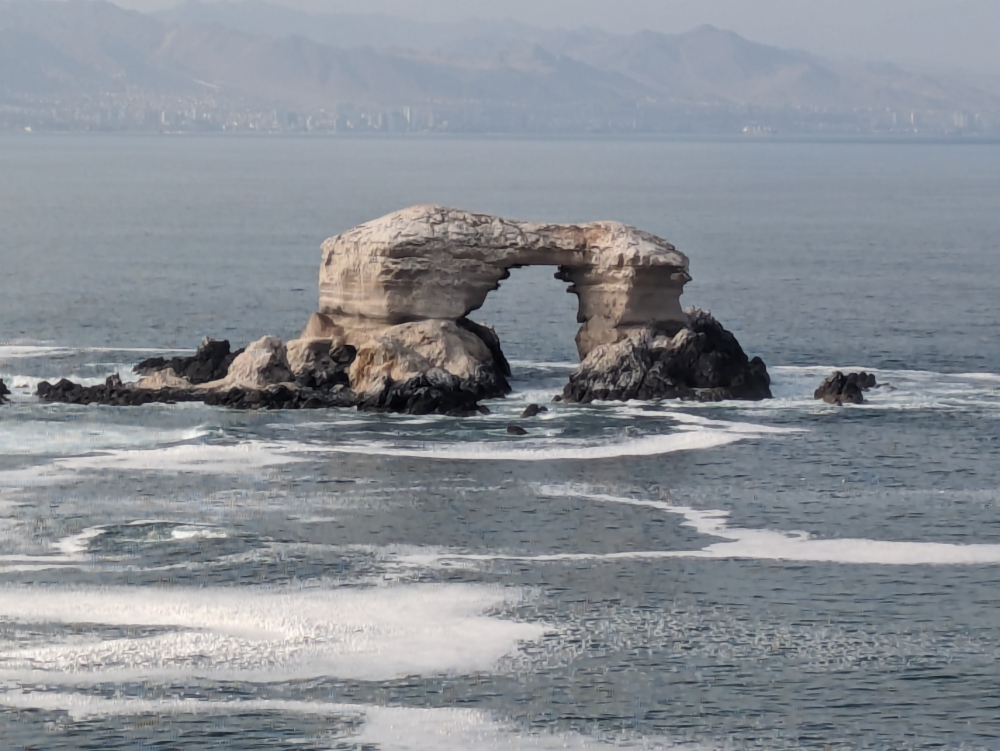
La Portada arch north of Antofagasta
Our first chore, having the truck (especially the undercarriage) washed, failed. We were too big for the few self-serve places and having it done professionally would cost $40. Just for the truck; $20 for the chassis and $20 for the body of the car. Insane! We never spent more than $10 on this before.
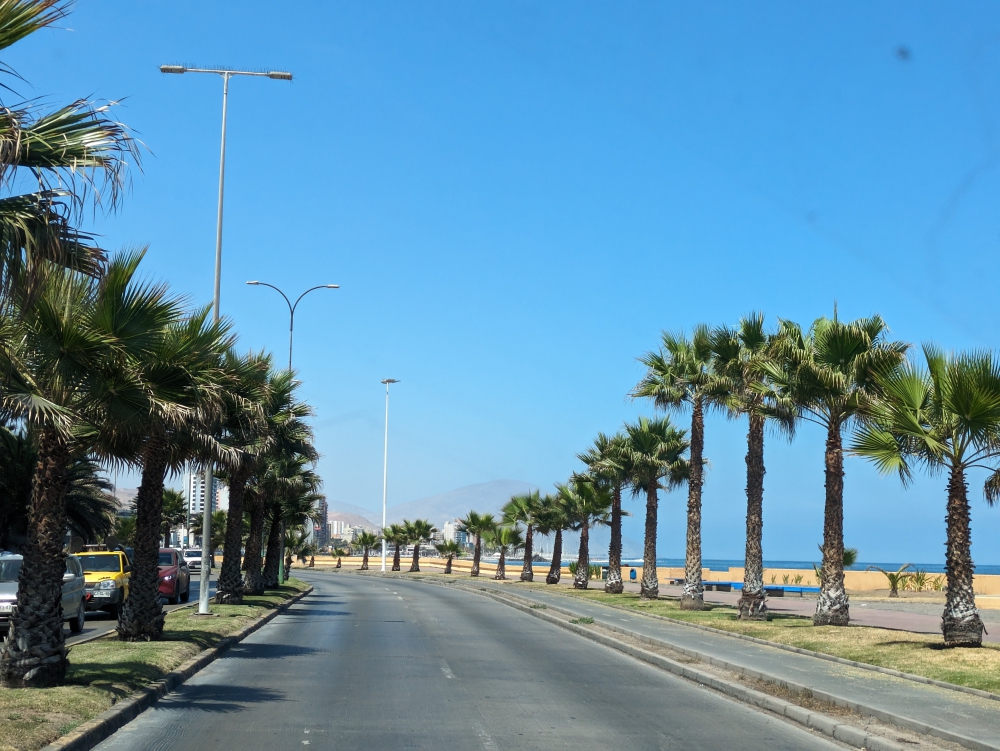
Coastal road through Antofagasta – a breeze to drive on
Topping up with fuel and water worked out, with only one little caveat. There was no handle on the tap. Next: another vet ordeal. I will spare you the details, but this involved a visit to a local veterinarian for another health check-up for Maya (this time to travel into Argentina), a new “flea and tick” Seresto collar ($60!), an extensive certificate, a walk to the SAG (government vet office) for other paperwork, being told this would take three days (too long for us), leaving empty-handed, and returning to the first vet to get some data corrected. We’d have to figure out what to do regarding SAG.
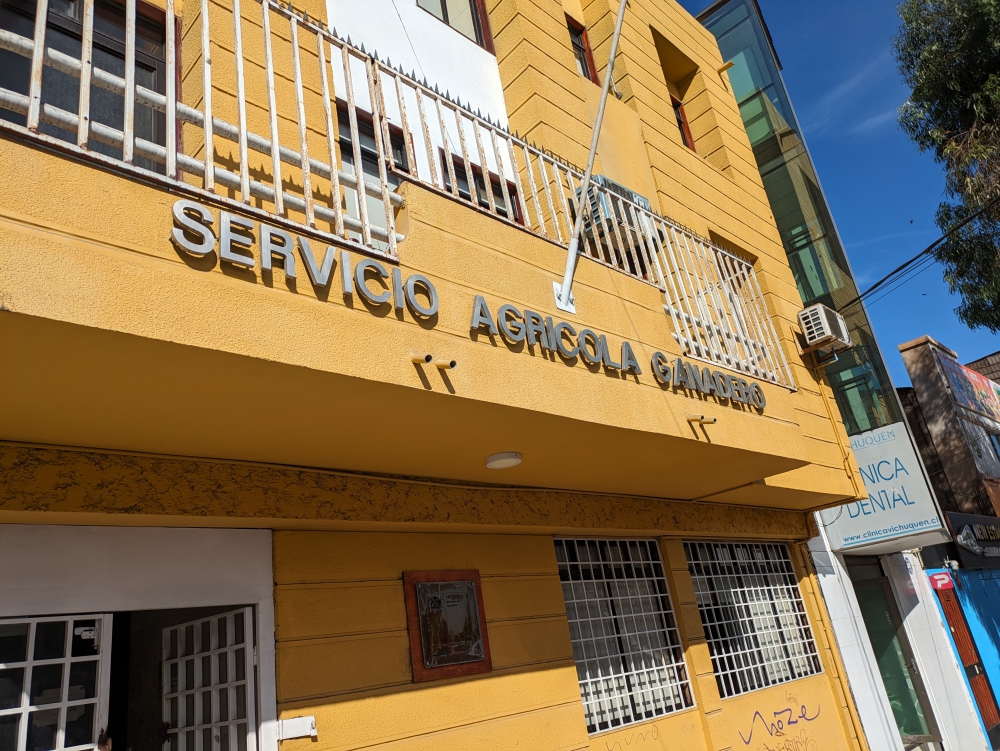
Another vet visit
A Chilean friend had told us about a big parking lot where we could take a breather from the city and shop for food. That was our next destination. Another local acquaintance helped us find a DIY car wash nearby. So, we had our sandwich lunch at 4pm, dropped laundry off at the most affordable and speedy shop around, removed the camper from the truck, and dealt with the carwash (Mark). I stayed with our vulnerable home and Maya.
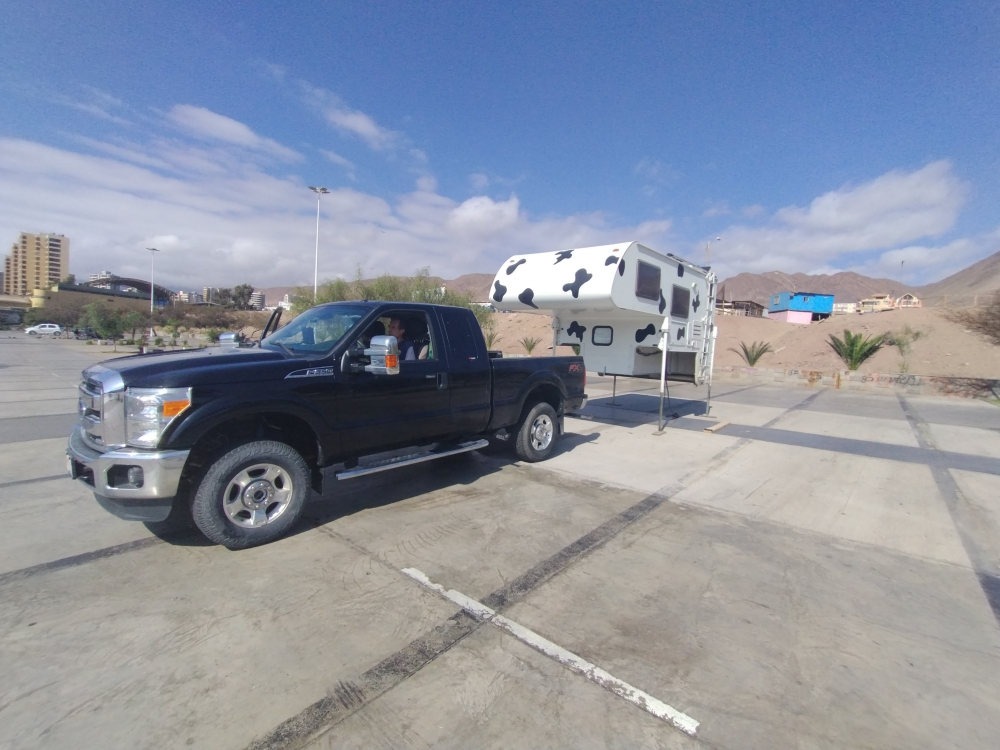
Quickly taking the camper off, so Mark could drive just the truck to a DIY carwash
When my husband returned from pressure washing the truck, we loaded the camper back on within half an hour (we are getting good at this) and moved to our camping spot for the night; a safe and quiet spot in a fancy neighborhood. This worked out well!
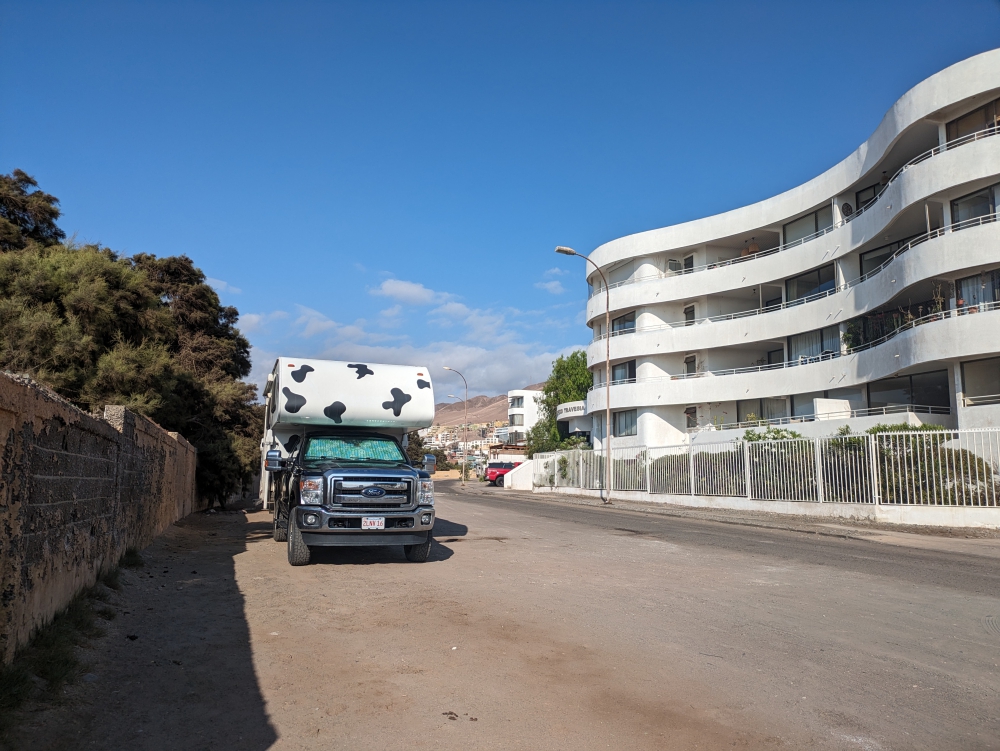
Camped for one night in Antofagasta
On day two in Antofagasta, we stopped by the SAG office at 9am, hoping for a quick turnaround regarding the international health certificate for Maya. We had done a bunch of research and created a back-up plan in case we would have to wait the full three working days. To our pleasure, everything was done and paid for within the next two hours. Phew!
We drove to a different parking lot near the seaside, asked an attendant to keep an eye on our vehicle in exchange for a tip, explored the historic downtown and fish market, and treated ourselves to a couple of seafood empanadas and a salad.
Then, it was time to return to our favorite, flat, and open parking lot, go grocery shopping, pick up our laundry, and make pricy copies of paperwork for future border crossings. We left the city at 4pm to reach my anticipated highlight of Northern Chile: Mano del Desierto.
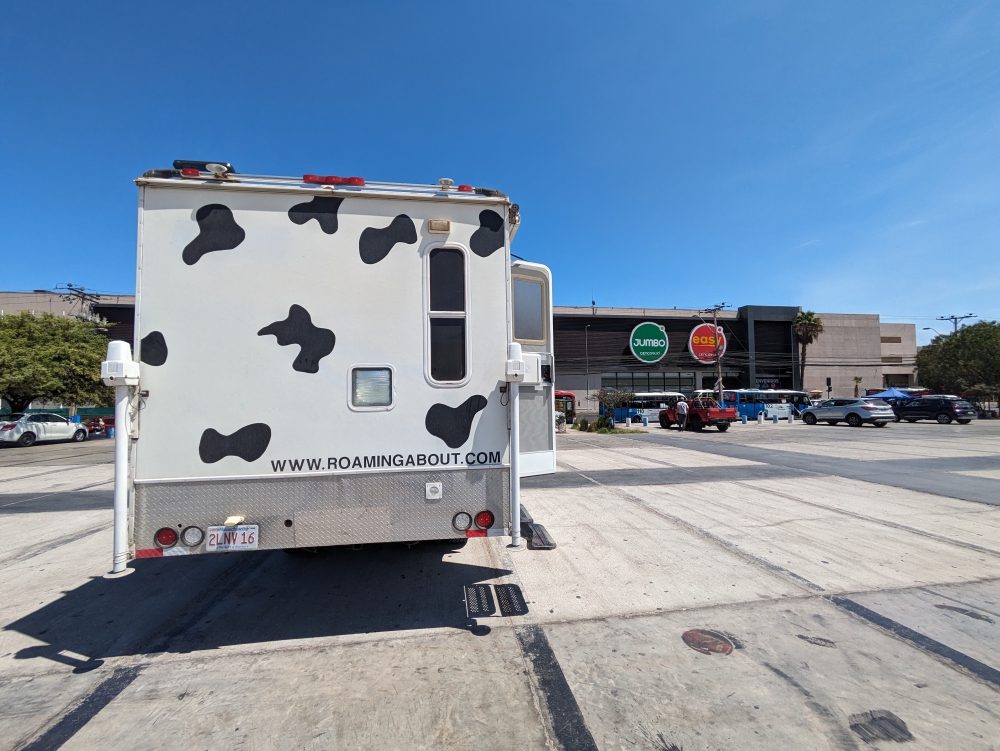
Parked at the big, flat parking lot to do some grocery shopping
Mano del Desierto
Everyone who drives by this monument along the highway stops, so it’s always busy. When we arrived at the Hand of the Desert by 5pm, it was extremely windy. A Patagonia-like blast of air made it hard to walk upright or even take a photo of the statue. I quickly persevered, before we faced ourselves nose into the wind for an otherwise peaceful night. After sunset, the air was still.
The following morning, I was up at first light (which is not impressive at all, since the sun rises at 8am) to take more photos of this mysterious and majestic hand rising from the desert.
I asked Mark to drive Thirsty to the statue for a family photo portrait, now that the wind was absent; a long-haul truck driver obliged. And, off we went again, to our last destination in Chile, San Pedro de Atacama.
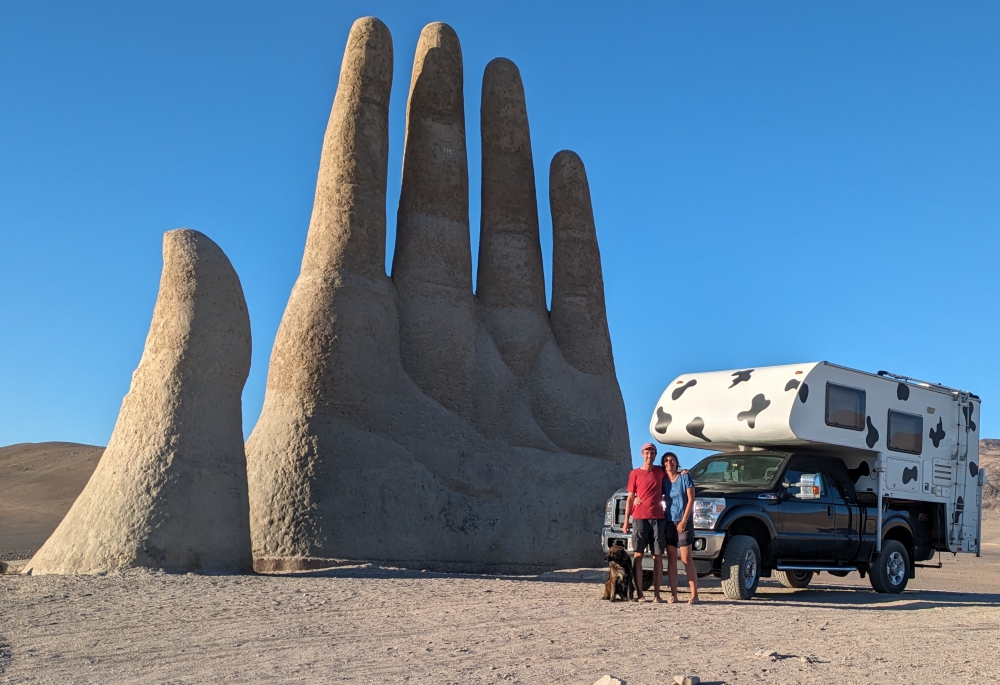
Family portrait in front of El Mano del Desierto
Baquedano
The (free) train museum in Baquedano, along the way to San Pedro, was worth a stop. I enjoyed this display better than the train cemetery in Uyuni, Bolivia.
San Pedro de Atacama
This blog post is getting way too long. Apologies for that.
The Magic Bus
There is a lot to see and do in the San Pedro area of the Atacama Desert. We picked a few attractions based on their entrance fees and how far they were out of the way. The Magic Bus in Valle de la Luna was reached by a slow, washboard road. The bus itself and the scenery were nothing special, but we did enjoy a quiet, restful night here.
Cactus Canyon
It was March 1st, Mark’s birthday. I made him a lovely special breakfast of crêpes with fresh fruit toppings, before we continued our drive.
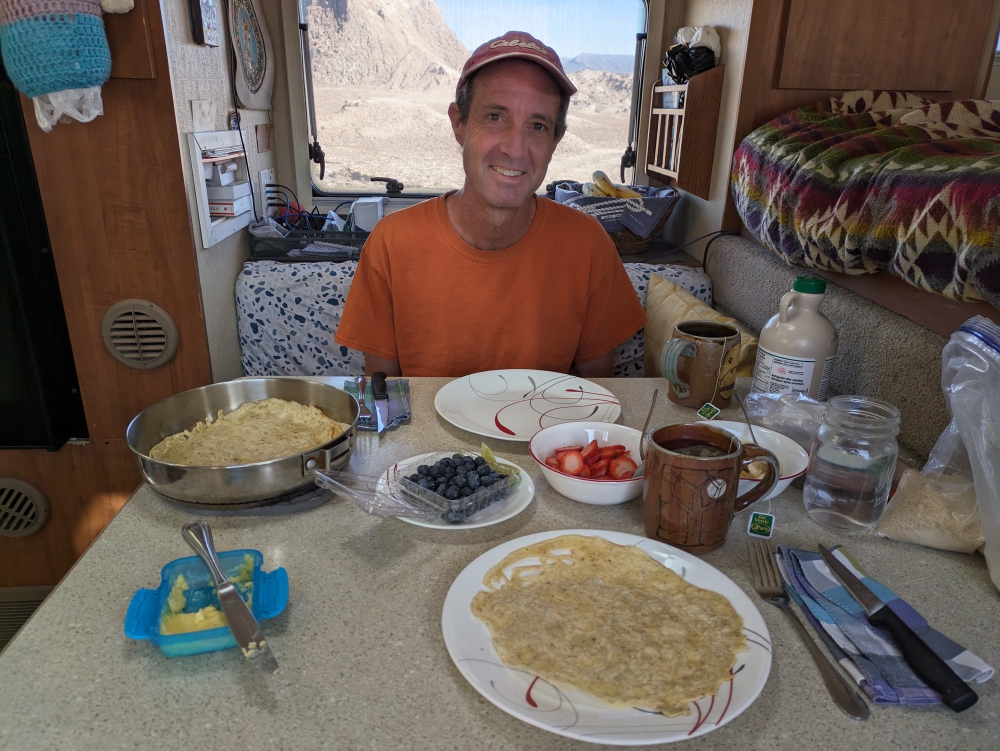
A special breakfast for the birthday boy!
Then, we stopped at a few uninspiring viewpoints and passed San Pedro to reach another natural area.
After a detour of ten miles each way (worth it), we arrived at the parking lot of a free natural reserve consisting of a clear river in a pretty canyon covered by cacti. Soon enough, the three of us were splashing in its refreshing water. The rest of the day revolved around relaxation and good food and drinks.
The next morning, we followed the river downstream, passing multiple rapids and waterfalls and taking a welcome shower in one of the pools. This was an incredibly attractive and beautiful oasis, which we thoroughly enjoyed for a couple of days.
Devil’s Throat
We couldn’t linger longer at our little canyon paradise, because Maya’s health certificate to cross into Argentina was only valid for ten days. So, we left for a hike in the Devil’s Throat, discovering piles of trash along our shortcut.
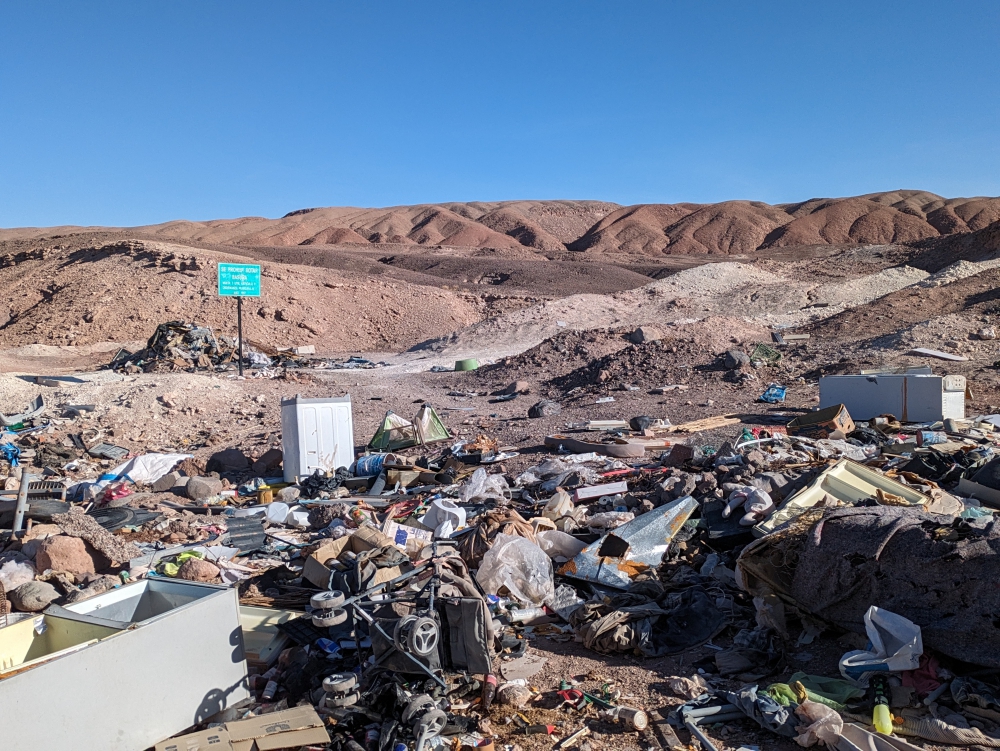
Garbage dump along the road – the green sign warns to not throw trash!
The entrance fee into this valley was steep at $5 per person for just a walk, and Maya wasn’t allowed in. Because it turns hot quickly in the desert – for us outside and for Maya in the camper – Mark and I walked this 4km trail at a swift pace, climbing up to a viewpoint, and returning the same way, surprised to see dogs joined by bikers.
We drove along the washboard road in this canyon for another fifteen minutes to glance at the cute, remote San Isidro chapel. On our drive back out, we stopped by a turnoff for an abandoned tunnel. This extra hour-long hike was extremely hot and dry, and a bit too much for me. Maya and I rested in the shade at some point, while Mark persevered until the end.
San Pedro town
By mid-afternoon, we settled for the night in an unlevel spot next to the cemetery. It was still hot and the wind caused dust to surround us at all times.
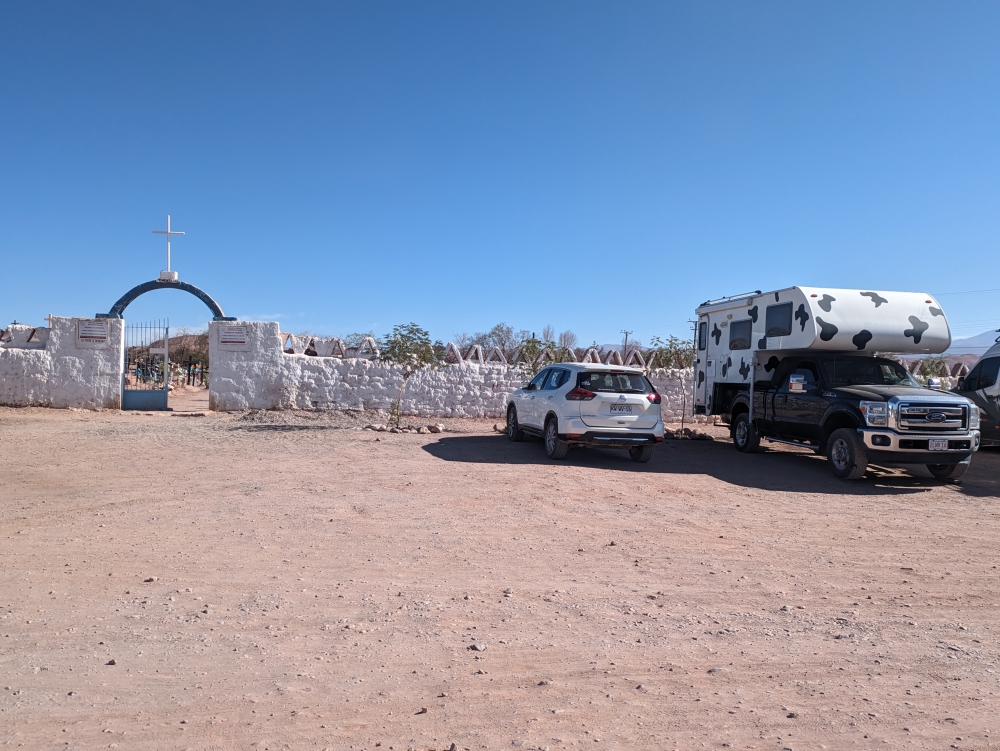
Our camping spot next to the cemetery in San Pedro for one night
San Pedro felt like a step back from the other places we visited in Northern Chile, almost like we had returned to Bolivia, just across the border. Roads were sandy, dogs ran loose everywhere, and trash cans proved hard to find.
The downtown area was cute, but we had no reason to stay longer than one night and soon moved on to another camping spot towards the border with Argentina; a spot with a nice view of a volcano and at a higher elevation. It was a great place to finish this whirlwind tour of Northern Chile.
Curious about a previous ten-year chapter in our nomadic lives, which includes eight years aboard a 35-foot sailboat in the tropics with dogs, check out my compelling, inspiring, and refreshingly honest travel memoir:








































































































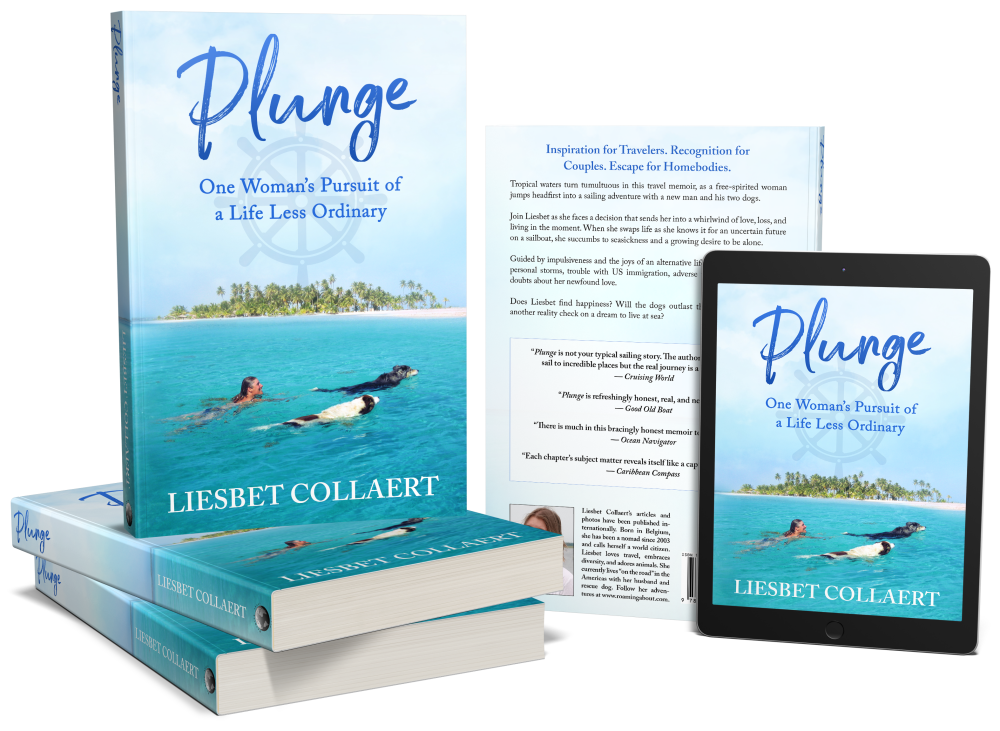




March 23, 2024 at 16:19
I love reading about how your journey is unfolding: the good, the bad, and the frustrating. I can’t wait to read about Patagonia. Hope your trip continues safely.
March 24, 2024 at 19:36
Hi Heidi,
Isn’t it nicer to read about other people’s journeys and (mis)adventures from a comfy chair sometimes? Especially seafaring trials and tribulations. 🙂
You’ll have to wait a while regarding Patagonia as we won’t drive there until the next austral summer, towards the end of this year. But, I’m looking forward to those natural surroundings as well. The crazy winds, not so much.
March 23, 2024 at 17:02
Another engrossing read, Liesbet, from the first word to the last. I sure couldn’t put it down! Our so-called adventures are so tame compared to yours. Loved reading the tales you spun and photos of course. We drove from Uyuni to San Pedro de Atacama on a small tour.
Unfortunately, never got to see the Hand in the Desert – what a sight! Thank God you and Mark got out of the soft sand with the help of so many others plus your own grueling shoveling in the heat!
.
March 24, 2024 at 19:40
Hi Annie,
I’m glad you enjoyed reading about our latest sagas and you stuck with it until the end! 🙂
That trip you did from Uyuni to San Pedro de Atacama is probably one of the most stunning routes in South America and super diverse. We decided to skip driving on that crazy washboard road and tried to recreate the landscape vistas on other roads combined.
Yeah, we got a bit desperate there in the sand, after two attempts to be pulled out failed. We had no idea how long we’d be stuck. Usually, we get out of hairy situations a bit quicker than 24 hours!
March 23, 2024 at 17:23
Wow, Liesbet, that’s a lot of adventure in a single post! That hand sculpture is fascinating. I hope Argentina’s roads are as nice as Chile’s.
March 24, 2024 at 19:42
Hi Janis,
Nope. Argentina’s roads are back to the usual. Some of them are okay, but the worst one so far hasn’t been gravel or washboard, but grooved pavement on road surfaces ruined by heavy trucks. Mark would have to stay in these grooves and concentrate hard, so he wouldn’t “jump” out of them and loose traction. Also, every pothole within the grooves cannot be avoided, so we’ve had some serious bumps and messes in the camper again. 🙁
March 23, 2024 at 18:15
What a journey! Getting stuck in the sand–how scary.
March 24, 2024 at 19:45
Hi Jacqui,
I guess the sand episode was yet another challenge conquered – eventually and with the help from others. We’d like to think it was karma, as we have pulled, towed, and pushed out plenty of cars in our years on the road. Mostly in Mexico. Also, a mere two days later, we helped push out a car at one of the beaches we stayed at in Chile 🙂
March 23, 2024 at 19:27
Hi, Liesbet – I continue to admire the bravery, resillence and incredible problem solving of the three of you. That hand in the desert is amazing.
Happy belated birthday to Mark!
March 24, 2024 at 19:46
Hi Donna,
Thanks for the birthday wishes for Mark again. That hand was really something. Mark didn’t think it was that special, but I was a fan. We are ready for less problem solving, meaning less problems! 🙂
March 23, 2024 at 19:28
What a horrible experience, getting stuck!
March 24, 2024 at 19:47
Hi Anabel,
Yeah, being swallowed by the sand monster – twice – was probably our least favorite experience of this trip so far. Of course, there are some strong (and more dangerous) contenders as well.
March 23, 2024 at 21:04
I’m glad to hear you got your camper out of the sand. What a stressful experience. The Hand of the Desert looks fascinating. I stayed in San Pedro and enjoyed my visit to the Atacama desert when I was in Chile. Safe travels!
March 24, 2024 at 19:49
Hi Natalie,
San Pedro is a popular tourist town in Northern Chile, and for good reasons. There is a lot to see and do in the surroundings. Most require a tour if you don’t have your own transportation, so that might get expensive. Of course, when on holiday, money is less of an objective. 🙂
March 24, 2024 at 10:17
Long, yet very interesting…in the edge of my seat at times, and a great read!!! The hand is amazing and the stuck Bella was grueling, even to read. Way to persevere! I hope all the highlights outweigh the low ones. Amazing journey. I’m a loyal follower, even when I don’t take the time to comment! Best to the three if you!
March 24, 2024 at 19:52
Hi Carol,
Thank you for your sweet comment and dedication. I’m not sure why WordPress doesn’t remember your sign-in credentials. I’m sorry you have to add all your information again, each time you comment. Such a hassle.
Yes, the positives still outweigh the negatives on this trip, otherwise we’d have to start considering an exit strategy. That being said, we are getting ready for a break from the road, though, and would embrace a few months of not having to worry about “anything,” ideally in a western country… Stay tuned! 🙂
March 25, 2024 at 10:42
Whatever you choose to do, you won’t be bored!
March 27, 2024 at 12:27
Haha! That is the truth, Carol!
March 24, 2024 at 10:45
Your posts are always jam packed with detail, it’s hard to know how to comment, Liesbet. I will say I noticed the Walmart logo–yellow, sun spokes. And your recovery from the tire saga was engrossing. Wherever you go, there are obstacles, but also helping hands too. Your travel is certainly a more intense version of most people’s lives.
I understand that you don’t want to miss anything. Favorite photos: Mark enjoying a birthday meal and the family photo in front of the hand statue, so impressive. 😀
March 24, 2024 at 19:56
Hi Marian,
I admit this post was way too long. The issue is that I’d like to incorporate some of our lifestyle challenges into the sightseeing sections and that means there is a lot to share! I will have to start cutting that down in the next blog posts! Or write shorter posts, more often. Sigh. I need more time!
Haha, I love your description “intense” for our life on the road. That’s pretty much spot on! 🙂
Thanks for sharing your most favorite photos with us. I’m pretty sure that family portrait in front of The Hand will make it on the family calendar of 2025!
March 24, 2024 at 13:14
When you wrote about running low on fuel, I felt your pain since that is one of my greatest fears. Wow, the history of Humberstone!! 2,000 civilians massacred in 1907, and only acknowledged 100 years later in 2007. Iquique sounds like a wonderful place. What a story about being stuck in the sand. As I was reading this out loud to Carmen, my stomach started getting upset and I had to stop and talk to Carmen about what I was reading. So glad it finally ended well. Mano del Desierto… fascinating!! Thanks for sharing! Jim
March 24, 2024 at 20:05
Hi Jim,
I think I read on your blog before that you fill your car often. I believe before the tank is even half empty? We are the opposite. The soonest we’d usually fill our gas tank is when it’s 1/4 empty or when the light comes on (which is conservative, based on calculations). But only when we know there are gas stations around.
In Chile, we had no idea gas stations would be far and few between and ONLY in cities! In Northern Chile we didn’t see any fuel stations along a nicely paved highway ever. This meant stretches of 100 or 200 miles between stations are not uncommon. Now, we know! 🙂
There are actually a lot of different estimates about the death toll at the school massacre of 1907, depending on the sources. Such a heartbreaking and disastrous outcome that was, but not uncommon in certain political situations down here.
Sorry to upset your stomach about our sand episode. Many lessons learned and a super big relief to get out and be free. What a mess that was! Literally and figuratively! I hope the photos of The Hand provoked better emotions. 🙂
March 24, 2024 at 14:10
It was so nice to read that you’d finally found some lovely places! (Although I admit that the whole time I was reading your account, I was braced for something bad to happen.) Getting stuck in the sand sounds like it was a miserable ordeal, but at least you had good neighbours!
March 24, 2024 at 20:11
Hi Diane,
I guess I stuck to that “eventful” title for our time in Chile, like I mentioned to you earlier. Even though this word should be inferred for anything to do with this lifestyle, haha.
You know, on beaches in the Baja Peninsula, there are “sharks” waiting with their heavy-duty pickup trucks and tow gear to rescue oblivious tourists who get stuck in the sand. When our neighbor first showed up, all prepared and within minutes of us starting to dig, I thought he was the local “rescuer”, hoping to make a buck off the misfortune of ignorant people like us.
I couldn’t have been more wrong and felt bad about my first thought afterwards. Our neighbors – all Chileans – were super helpful and compassionate.
March 25, 2024 at 04:45
Lots of variety!
I love that picture of the hole in the sand you guts dug getting Thirsty Bella out. So sorry you got stuck. We have camped pretty slanted, but we still had access to our water. Makes me think that it’d be a good idea to have a container of spare water stored somewhere.
I miss camping by the ocean. Maybe again, someday!
Do you see a lot Chilean RVers?
March 25, 2024 at 07:25
Hi Duwan,
Yeah, that hole ended up being pretty deep after we were done digging and moving. We tried to take photos of different angles, even with Mark and Maya in it, but the only photo that showed decent perspective was the one I posted.
I have to admit that I’ve been much less adamant about being completely level after this experience and I’m okay sleeping a tad unlevel when needed. It’s the cooking that’s the hardest. When the oil sits on one side of the pan, it’s annoying to make food in it!
I now have a growler filled with extra water, but the thing is that it will turn foul at some point and then we have to waste it. In all our overlanding years, this, really, was the first time we were in this water predicament, though. Because we were digging and sweating so much, we had drunk everything in our water bottles. Luckily, I managed to squeeze enough water out of the lines to almost fill one bottle to get us through the night. To not have enough drinking water is quite shocking to live with. Especially with my headaches and tendency to not hydrate enough.
I wish we spent more time at that beach, on hindsight. It could be relaxing. But, the salty air and wet sand make things complicated as well.
Yes about the Chilean RVs. People have money there and we saw heaps of them during their summer vacation. We will see how it looks like when we return to Chile later this year.
March 25, 2024 at 19:17
Wow, what a tour! Happy Birthday to Mark and I am sorry about the sand ordeal. I hope you will never need this advice, but last time we got miserably stuck and had to spend the night in a slanted van I found that if I line a pillow along the lower side of my body, everything straightens up magically.
March 27, 2024 at 12:30
Hi Margie,
Thanks for the tip about sleeping “more straight” on a slant! Yeah, we hope we won’t ever have to do that again, but this wasn’t the first time, so I doubt it will be the last! I guess you two have experience with getting stuck as well, huh? 🙁
March 27, 2024 at 13:46
Haha, indeed we do! We spent a very lonely night in the UP in Michigan. I didn’t realize it was considered wilderness…https://backroadsandotherstories.com/2022/10/22/pukaskwa-camp-hosting-sep-26-our-misadventure/
March 29, 2024 at 20:00
Wow! I’ll have to read about that (mis)adventure one of these days! Thanks for the link.
March 26, 2024 at 16:24
OMG, I’m shaking my head in awe at your incredible predicaments and stories. You definitely need to write a book on your South American travels. I felt like I was right there with you guys while you were stuck in the sand! Just incredible! <3
March 27, 2024 at 12:32
Hi Debby,
Thanks for reading through the entire saga. And, yes, I have a lot of stories to share about this trip in SA by now. Just to think about them exhausts me, so writing about them will have to wait until life becomes more comfortable and steadfast again for a while. Maybe even boring. One day… Or not. 🙂
March 27, 2024 at 13:51
I feel like I just read a novel. An exciting one full of plots (and potholes) and digging deep into adventure, sand, dog permits with a gorgeous setting. I learned so much! And I shook my head as I read – I’m so non-adventurous compared to you three. Thanks for taking me along in the story.
March 29, 2024 at 20:02
Hi Pam,
I’m glad you enjoyed our whirlwind time in Northern Chile. Believe me when I say that sometimes there is too much adventure involved, even for us. We crave a balance between excitement and peace and always look forward to a nice place where we can sit for a while. Unfortunately, that rarely happens (for multiple and varying reasons) and the quest can be tiresome.
March 29, 2024 at 07:56
This one post alone could be a whole chapter, Liesbet. Honestly, I was on the edge of my seat for most of it. Thank you for showing us sights I’d never have dreamt existed. That hand in the desert is an amazing sight.
How great to see those lovely smooth roads and read about people being polite and courteous. But the heat and horseflies would have gotten to me. I didn’t realise there were so many volcanos in that part of the world, but I suppose it is the pacific rim, so make sense. The climb up sounded exhausting. I’d have stayed with you and waited for Thirty Bella to pick us up.
Glad you found such a huge supermarket too. And I’m hoping it was comfortable to shop in.
March 29, 2024 at 20:29
Hi Hugh,
When I was writing this blog post – which took forever – I was aware it could be one chapter in a book. It’s long and a lot happens. But, man, this next book will become a tome if I’d put all that info and those events in it, haha. Like in Plunge, I’d have to pick the most enticing, adventurous, and emotional bits of the lifestyle. The getting stuck in the sand would be the singled out event in this case!
Oh, I have dreams about those smooth roads and awesome supermarkets in Chile these days. Wow. Northern Argentina is another step back in time!
March 30, 2024 at 05:09
I agree, Liesbet. The getting stuck in the sand bit is a must for the next book. My heart was certainly in my mouth while reading that part of your post. I can’t imagine how you were both feeling when all of that was going on.
March 30, 2024 at 14:46
Oh, Hugh, the getting stuck in the sand was probably the most mentally challenging event on this trip so far, as, you know, we were stuck without any idea about how – and when – to get out.
Usually, situations like these (when it comes to others) have a solution within a few hours. So, when we had to spend the night like this, that’s when we felt a tad desperate. We figured we’d have to contact a towing company the next day and that would have cost $200, a massive chunk out of our budget. You can imagine our relief when we got freed! One of those moments when you tell yourself you will never ever complain about the little things in life, haha.